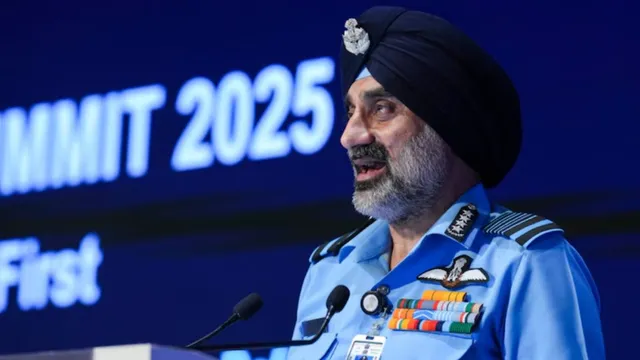- By Talibuddin Khan
- Fri, 03 Oct 2025 01:30 PM (IST)
- Source:JND
Air Chief Marshal Amar Preet Singh on Friday hailed India's "Operation Sindoor" against Pakistan and said that the synergy of the three Armed Forces brought Islamabad to its knees, with Pakistani leadership asking for a ceasefire. He further called India's precision strikes on Pakistan-based terrorist camps and the quick termination of the hostilities "a lesson for the world, which will go down in history".
AP Singh said that the Operation Sindoor was started with "very clear" aims and the operation was terminated after India achieved its military objectives in a "very quick time without just prolonging it".
"A clear directive, clear mandate was given to the Indian Armed Forces. It stands as a lesson which will go down in history that this is one war that was started with a very clear objective and it was terminated in a quick time without just prolonging it," Air Chief Marshal Amar Preet Singh said while addressing the 93rd Air Force Day celebrations.
#WATCH | Delhi: On Operation Sindoor, Indian Air Force chief Air Chief Marshal Amar Preet Singh says, "...A clear directive, clear mandate was given to the Indian Armed Forces... It stands as a lesson which will go down in history that this is one war that was started with a… pic.twitter.com/FJuEpFdVQi
— ANI (@ANI) October 3, 2025
Hailing India's decision to stop its strikes on Pakistan in just four days, the Air Chief Marshal said that the world is witnessing two ongoing wars, with no party talking about the termination of hostilities.
"We are seeing what is happening in the world, the two wars that are going on, there's no talk about termination. But we could make them reach a stage where they ask for a ceasefire, ask for termination of hostilities," Air Chief Marshal AP Singh said, adding, "We took a call as a nation to terminate those hostilities because our own objectives are met. I think this is something that the world needs to learn from us."
Air Chief Marshal AP Singh Lists Losses Incurred By Pakistan During Operation Sindoor
Giving details of the losses incurred by Pakistan during Operation Sindoor, Air Chief Marshal AP Singh said that 4 to 5 Pakistani fighter jets, most likely F-16s, were destroyed on the ground during India's air strikes. Apart from fighter jets, the IAF also targeted several Pakistani airbases, damaging radars, command centres, runways, hangars, and a surface-to-air missile system. A C-130-class aircraft and possibly a high-value surveillance aircraft were also hit during the operation.
"As far as Pakistan's losses are concerned, we have struck a large number of their airfields and we struck a large number of installations. Because of these strikes, radars at least four places, command and control centres at two places, runways of course damaged at two places, then three of their hangars in three different stations have been damaged," he said.
#WATCH | Delhi: Responding to ANI's question on the losses suffered by Pakistan during Operation Sindoor, Indian Air Force Chief Air Chief Marshal AP Singh says, "...As far as Pakistan's losses are concerned...we have struck a large number of their airfields and we struck a large… pic.twitter.com/qhf7yl27LO
— ANI (@ANI) October 3, 2025
"We have signs of one C-130 class of aircraft, and at least 4 to 5 fighter aircraft, most likely F-16, because that place happened to be F-16 with whatever was under maintenance at that time. Along with that, one SAM system has been destroyed," he added.
ALSO READ: Debris Of Pakistan Missile Fired During Operation Sindoor Found In Srinagar’s Dal Lake
"We have clear evidence of one long-range strike, which I talked about more than 300 km, which happened to be either an AEW&C or a significant aircraft, along with that five high-tech fighters between F-16 and JF 17 class this is what our system tells us," Singh said.

